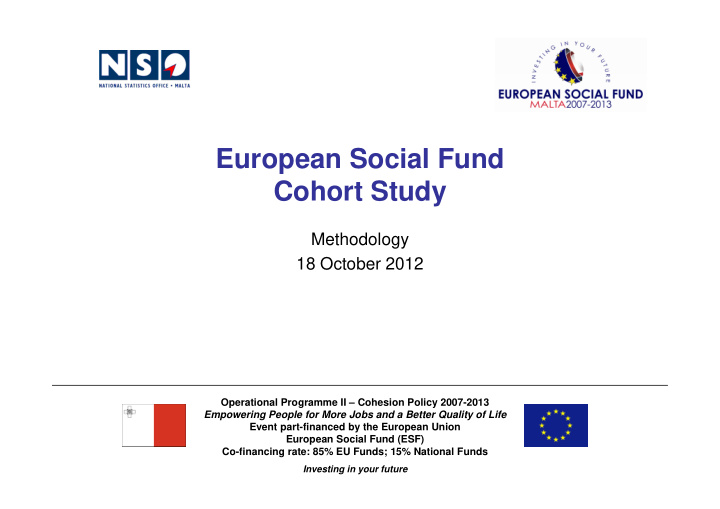



European Social Fund Cohort Study Methodology 18 October 2012 Operational Programme II – Cohesion Policy 2007-2013 Empowering People for More Jobs and a Better Quality of Life Event part-financed by the European Union European Social Fund (ESF) Co-financing rate: 85% EU Funds; 15% National Funds Investing in your future
Coverage and Response • The target population for the survey consisted of all persons who had successfully completed training which was co-financed by the European Social Fund (ESF) up to one year prior to the survey. • A total of 6,197 persons were eligible to participate in the survey. • A gross sample of 702 individuals was drawn from the Structural Funds Database (SFD) 07-13.
Coverage and Response - continued • The sample was selected using a stratified random strategy to ensure a representative count of the sample by gender, age and district of residence of trainees. • A total of 692 persons were contacted for this survey. • 310 persons participated, while another 118 persons where not eligible to participate in the study due to wrong contact telephone numbers. • A net effective response rate of 54 per cent was yielded.
Coverage and Response - continued Table 1. Distribution of effective gross sample by type of response
Data Collection • Data was collected by means of Computer Assisted Telephone Interview (CATI) between 21st and 26th June 2012. • Respondents were contacted by telephone. • Computers were used to enter the data obtained from respondents during the interview. • Each sampling unit is randomly assigned among interviews, and hence reduces interviewer bias to a bare minimum.
Data Collection - continued • Quality checks and in-built validation rules in the data collection program were implemented to limit the occurrence of non-sampling errors. • Missing data were imputed using statistical imputation techniques. • Any incorrect or logically misleading data was identified and checked.
Weighting of Results • Survey data was weighted and calibrated to correct for any biases present in the final sample of participating units. • Biases arise from different response rates observed in different categories • This served to align and gross-up sample estimates with the benchmark distribution in terms of sex, age and district of residence of trainees (for weights) as well as their employment status (for calibration).
Errors • The survey was subject to two main sources of errors, technically referred to as Sampling and Non-Sampling errors. • The margin of error quantifies uncertainty about a survey result and expresses the amount of random sampling error in a survey's results. • It is possible to calculate confidence intervals of the form estimate ± margin of error .
Errors - continued Table 2. Estimates of precision
Errors - continued • For example, the proportion of participants who felt that the ESF training will contribute in the future stands at 83.7%. • If a precise calculation is carried out the margin of error equals 4.8%. • From the previous table, this may be estimated using data for p=80. In this case the margin of error equals 4.3%*. • If the estimated value is considered, the 95% confidence interval is the range 79.4% to 88.0%, i.e. 83.7% ± 4.3%.
Thank you! Operational Programme II – Cohesion Policy 2007-2013 Empowering People for More Jobs and a Better Quality of Life Event part-financed by the European Union European Social Fund (ESF) Co-financing rate: 85% EU Funds; 15% National Funds Investing in your future
Recommend
More recommend